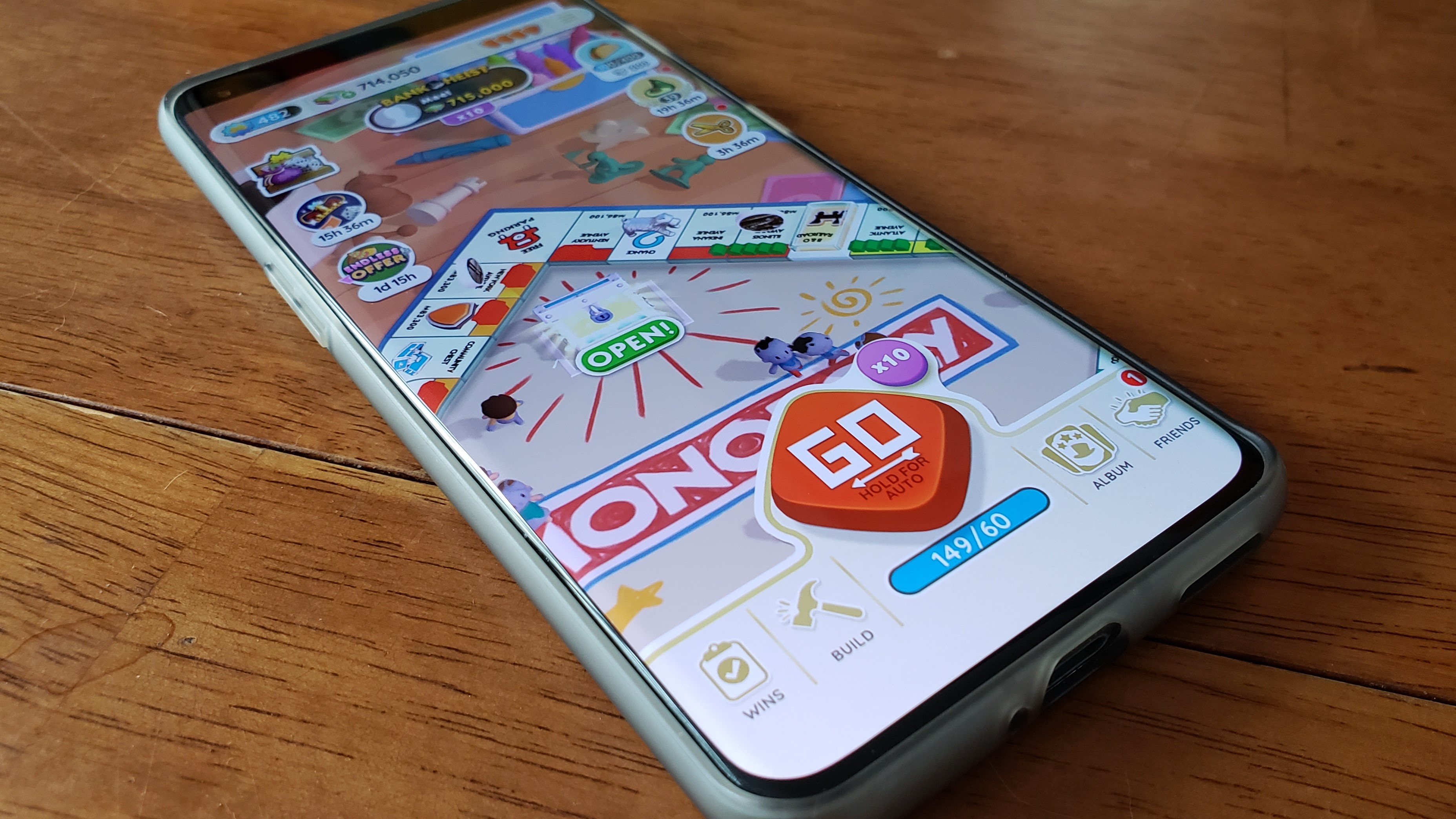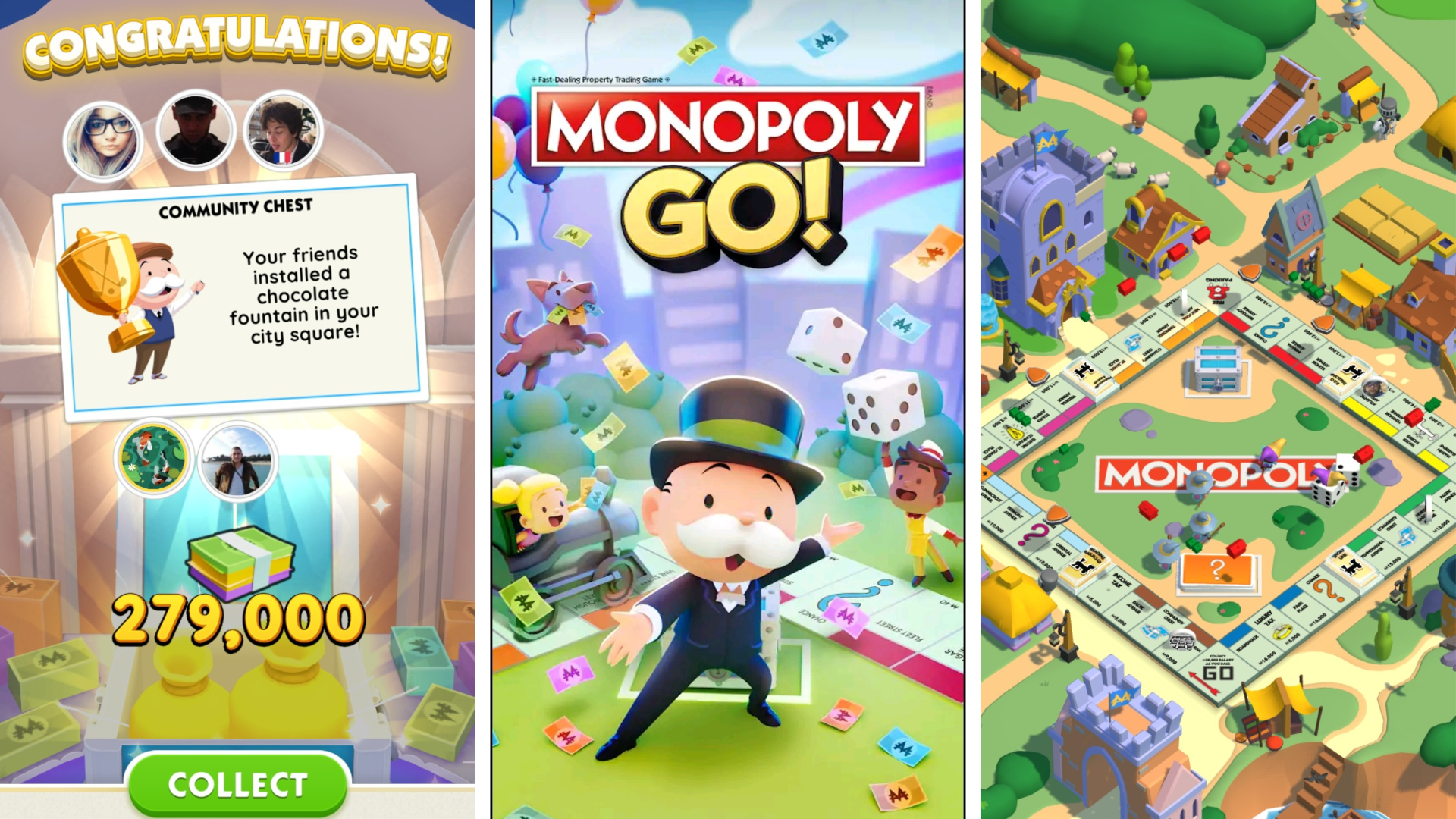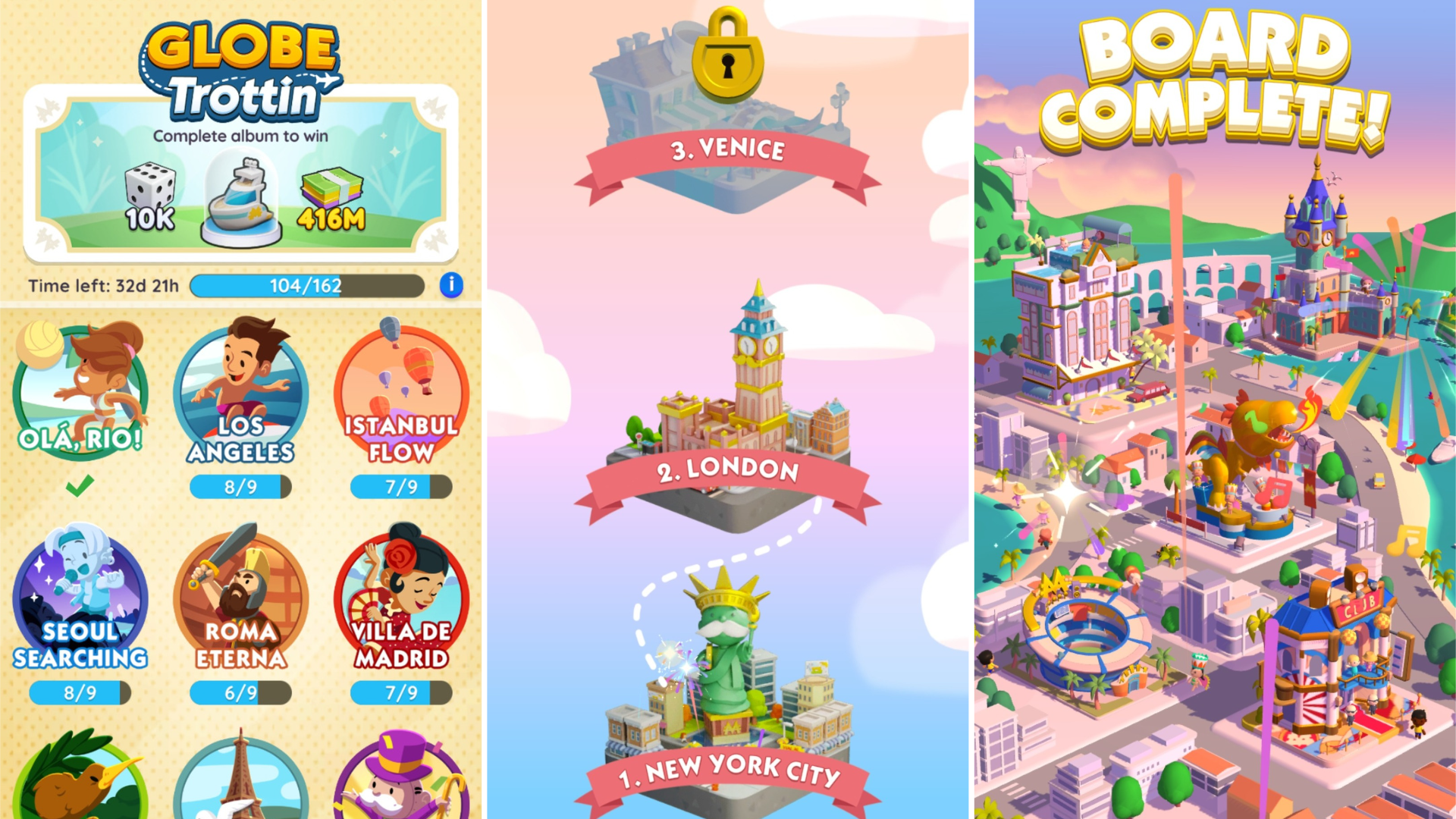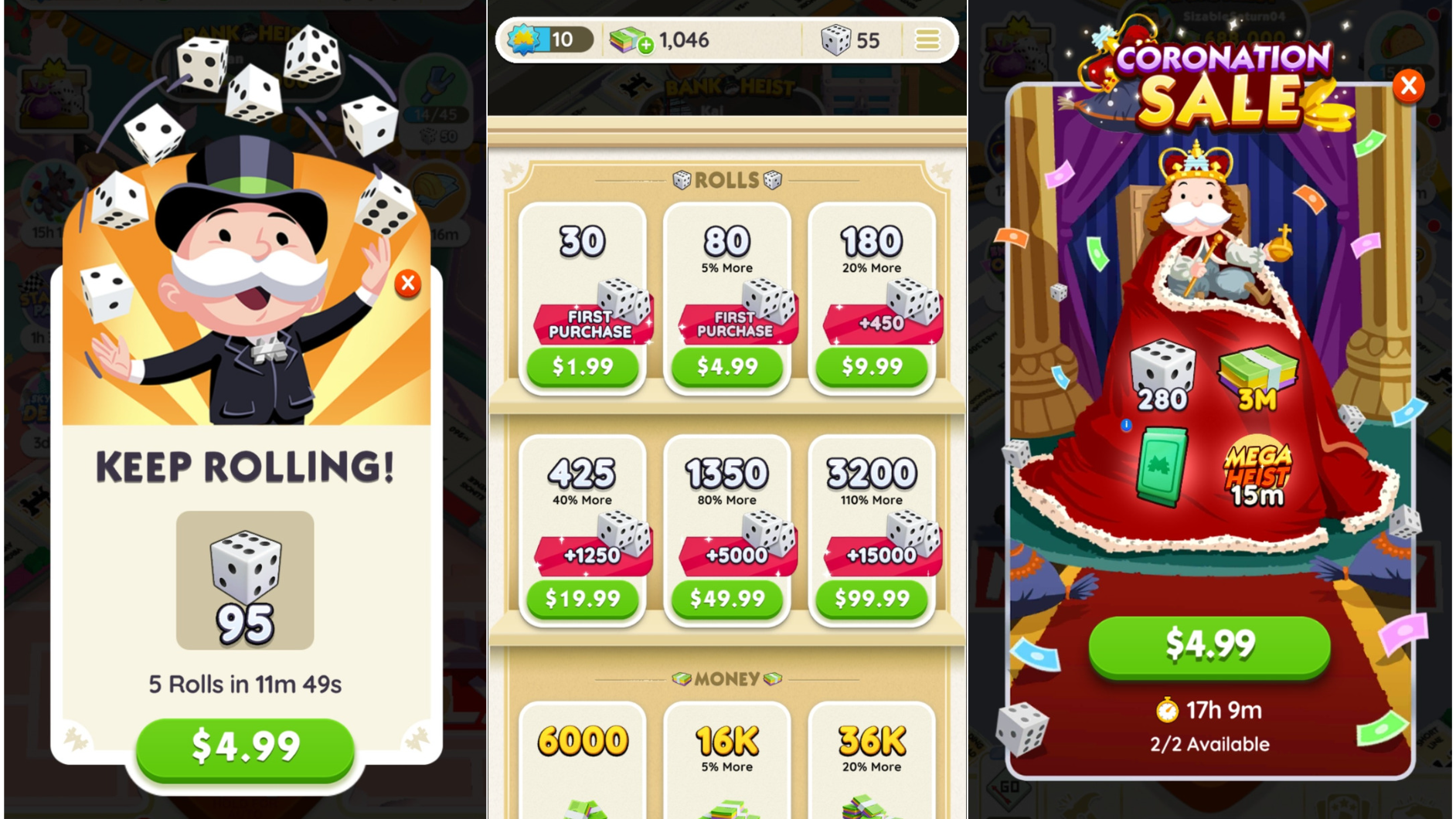
Over the course of the past month that I’ve been playing, it’s become clear to me that Monopoly GO! is all about expectations. As an avid board gamer, seeing a beloved board game get a good mobile adaption is always a delight. I was so excited to review this game, because I assumed (my mistake), that I would be playing Monopoly on my phone, which sounded like a great time!
That assumption led to some serious disappointment when I fired up the game for the first time and realized after 5 minutes of “playing” that Monopoly GO! was, beyond a shadow of a doubt, not Monopoly. That’s not to say it’s a bad game, but I want to make it clear now that if you go into Monopoly GO! expecting Monopoly, you’re setting yourself up for a bad time. Alternatively, if you go into it expecting a sleek, shiny, mindless time-waster tap-fest, you will be delighted by what you find.
That might sound like mean-spirited sarcasm, but it’s not; there’s a time and place for every type of game, even the mindless time-wasters. If that’s not what you’re looking for when you think “mobile board game”, then you can peruse our curated selection of the actual best mobile board games for Android instead.
With that said, let’s dive into the blinding, bustling world of Monopoly GO!
If it's not Monopoly, then what is it?

Originally designed as a way to illustrate the negative impact of concentrating wealth and resources under monopolies, Monopoly, as we know it today, has seen quite a few changes over its storied, nearly 100-year history. The modern version that most folks know and love (or hate...or love to hate) sees 2-4 players traveling around a board lined with properties for sale, jail, chance spaces, and annoying staples like income tax spaces.
Players all start with the same amount of money, gain $200 every time they loop back around to pass the starting GO space, and lose or make money by buying and trading properties, owing or collecting rent from other players, being blessed or cursed by the random chance spaces, etc.
The goal of the game is to dominate the board’s real estate by acquiring monopolies of same-colored spaces and then bleeding your competition dry of all their cash when they land on your properties. You win once everyone else is bankrupt.
Monopoly is cutthroat, strategic, and occasionally collaborative — teaming up with your younger sibling to knock your oldest sibling out of the running early on — and derives its fun from petty vengeance, backstabbing, and being the biggest jerk on the board. The rage is what makes it so great!
Monopoly's cutthroat tactics and strategic planning are completely absent, or at least fully defanged, in Monopoly GO!
And everything I just described is completely absent, or at least fully defanged, in Monopoly GO! From an aesthetic standpoint, Monopoly GO! bears all the stylings of the board game. All of the spaces are identical to the board game and some of them function the same, like the worthless Just Visiting space. The jail space still prevents you from rolling unless your roll doubles within three turns, income tax still sucks, and there are still ways to put houses and hotels on properties.
The difference lies in how you “acquire” and build up properties, because functionally speaking, you don’t. Monopoly GO! is a single-player experience in a lightly social ecosystem. You travel around your board completely alone and you already own all of the properties at the outset. Your goal then, is to instead build landmarks, the unique addition around which Monopoly GO! revolves.
As you make your way around the board, you get cash for almost everything. Rolling doubles, landing on any property, passing GO, and landing on railroads all net you cash. You use that money to build up your board’s five available landmarks, which are themed around your current board. For example, if you’re on the Tokyo board, your landmarks are things like Tokyo Tower, a Japanese market, a temple, a sleek hotel, etc.
Take-Downs and Bank Heists are both massively more profitable than any of the other actions on the board.
Each landmark can be upgraded six times (which also puts more houses or hotels on your board) and once you’ve maxed out all upgrades for your six landmarks, you complete that board and move on to the next one. This is Monopoly GO!’s core loop: roll dice, make money, spend money to upgrade landmarks, roll, make more money, upgrade more landmarks, complete the board, move on to the next board, and do it all over again.
Sprinkled in that loop are mini-events that can gain or lose you money. Notably, landing on any of the railroad spaces will randomly trigger either a Take-Down or Bank Heist event. Take-Downs allow you to damage the landmarks on another player’s board and Bank Heists allow you to steal money directly out of whatever cash reserve they have on hand. Both of these events are massively more profitable than any of the other actions on the board.
Turnabouts are fair play though, and other players can do exactly the same things to your board and your reserves. You might end a day with 250,000 still in your bank but come back the next morning to find that Josh has stolen 80,000 in a heist or bashed up your lovely landmark, which you now have to pay to repair.
The final clincher on all of this is tied to the game’s energy system: your dice. Monopoly GO!, like any other casual free-to-play title, imposes a daily energy system of X amount of dice per day. You start out with a low dice ceiling, but it naturally increases as you progress through more boards and boost your overall net worth.
You can roll normally and get forty turns out of your dice or you can play smarter and use a dice multiplier to roll more dice at a time, up to a max multiplier of 10 (this is the max I’ve personally made it to, but I believe the multiplier goes higher than this).
So if I only have forty dice for the day and I put my multiplier at five, then I’ll only get eight turns for that day. However, all rewards on the board have their values multiplied by five as well, so even though I have fewer rolls, I’m gaining far more money in the process. These multipliers affect Take-Downs and Heists too, so using those max multipliers at every chance is the only way to make progress in the game without resorting to in-app purchases.
Beautiful presentation, excellent sound design

As I said earlier, Monopoly GO! is a mostly brainless tap-fest, but that’s not necessarily a bad thing. After I got over my initial disappointment of discovering that I wasn’t actually playing Monopoly and adjusted my expectations to the casual free-to-play level, I started having a much better time.
Casual games play a vital role in our society. After all, what else could I have done while waiting over half an hour in my doctor’s lobby, bored to tears? Read a book? Have thoughts?! Over my cold, dead body. It’s in life’s many trials and tribulations of boredom that the casual game shines and Monopoly GO! is a nearly perfect time-waster. The gameplay loop, which is more observational than counting as actual gameplay, is frantically fast-paced and oversaturated with rewards to trap you into that “just one more turn” mindset.
For a free-to-play casual game, Monopoly GO! is relatively generous in how much cash and dice refills it doles out for free.
The game is also relatively generous in how much cash and dice refills it doles out. The daily energy system isn't nearly as restrictive as in other free-to-play titles, as daily challenges, limited-time events, chance spaces, and more can all generate additional dice for you to burn through. There have been days where I started at sixty dice but earned 200+ dice over the course of playing normally.
On the design and development side, Monopoly GO! runs seamlessly on my OnePlus 10 Pro, with the rare exception of some light stuttering when too many assets are cluttering up the screen. The bright color palettes, toy-like landmarks, and adorable collectible stickers all make for a pleasing, cohesive presentation that gives Monopoly GO! a more playful personality than its business-professional cousin.
The sound design is where the game really shines, though. The cute tapping sound effects as your classic silver pieces scuttle around the board make things feel surprisingly tactile while smacking your wrecking ball into landmarks and getting a big burst of cash flying into your wallet is extremely satisfying.
Even the non-intrusive background music is pleasant, with just the right light-hearted tone to keep you feeling relaxed, yet entertained. There's actually a lot to like here if you can forgive the game's drawbacks.
Ruthless drive for profit and mobile gaming go hand in hand

The problems with Monopoly GO! boil down to two things: shallowness and pushy monetization. Truly, the two horsemen of the mobile gaming apocalypse.
There is no real strategy here beyond optimizing your spending on landmarks and even the social aspect is disappointingly sterile. You never actually interact with the other players in your circle and who you attack, who you steal from, and whose tokens are on your board to collect rent from are all randomly generated.
There's no impactful choice in Monopoly GO!, you just do what the gods of randomness tell you to and get rewarded for it. There are also precious few pitfalls to increase your level of risk, which serves to further dull the biting edge that Monopoly classic offers.
Even when another player steals from you, they don't ever really get that much out of your vault. And if you're consistently spending your cash to keep your landmarks upgraded, then there isn't even really anything to steal, making heists against you a non-threat.
Monopoly GO!'s problems boil down to two things: shallowness and pushy monetization.
The same thing goes for your landmarks. You can acquire shield tokens by landing on them around your board, which then gives your landmarks a certain amount of armor from opponent Take-Downs. But even if you don't have any shielded landmarks, the cost to repair a landmark is quite low in comparison to the cost you paid to build it in the first place. Another non-issue.
And the ads. Sweet lord, the ads. Monopoly GO! is a heavily monetized game, from its store packed with dice and cash bundles to the absolute flood of special "limited-time" themed promo bundles. The game will throw these promo bundles in your face at every chance, usually at least 2 in a row, sometimes 3-4 in a row, multiple times per play session. Closing out these ads, again and again, is half the tapping you'll do during a session!
For a game that offers so little meaningful gameplay, it's a big ask to force players to slog through the upper-level grind all while battling through an army of in-game IAP ads.
Should you play it?
If you're looking for an easy, casual boredom defender right in the palm of your hand, Monopoly GO! is literally the perfect game for you. It's free, you can make tons of progress without ever touching the in-app purchases, and it's just engaging enough to keep your attention for the 5-15 minutes a day you're likely to play it before your in-game energy runs out.
It looks good, it plays well, and it sounds great. The problem is that it's abundantly clear that Monopoly GO! is one of the many mobile games designed for the sole purpose of making as much money as it possibly can. It's not really interested in offering up meaningful or interesting gameplay; it just wants you to spend money. Spiritually, that puts it poetically in line with the lessons the original Monopoly game was meant to teach. It's a common problem in both mobile and PC/console gaming these days, but you still hate to see it.
Considering the source material it pulls its inspiration from, it's a real shame that there isn't any more strategy or more directly social aspects to the game, like the exceptionally well-designed Sagrada mobile board game. Alternatively, if they had taken a concept like Monopoly Deal, the lite card game version of Monopoly, and translated that into a mobile experience, it could have been awesome.
But for what it is, I guess the casual mobile tap-fest is fine, too.







